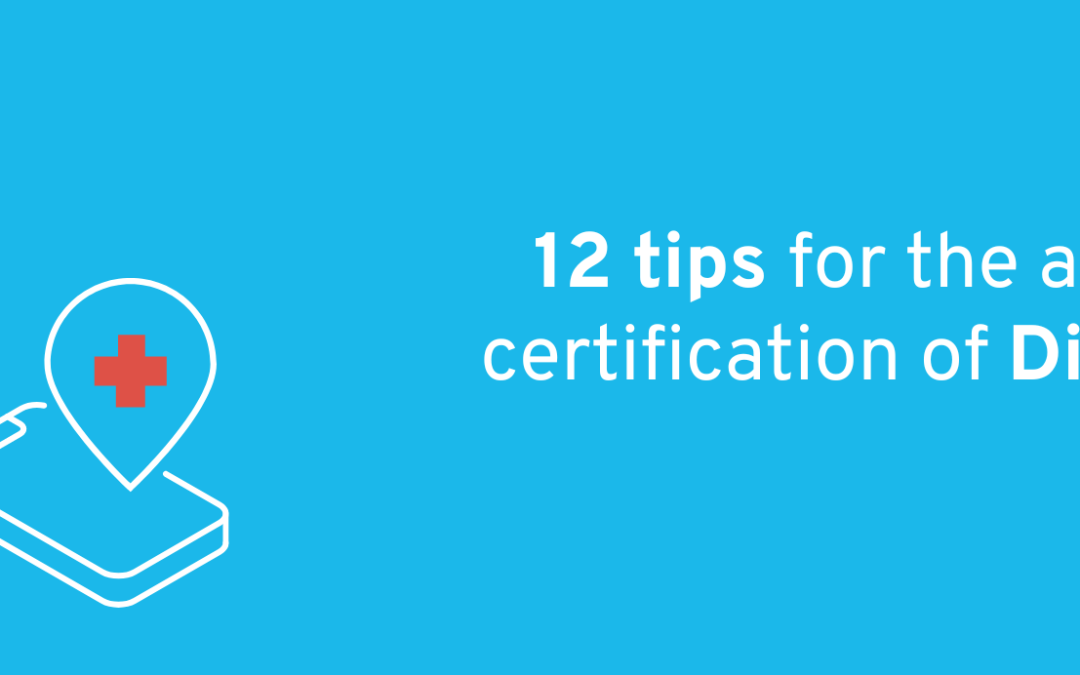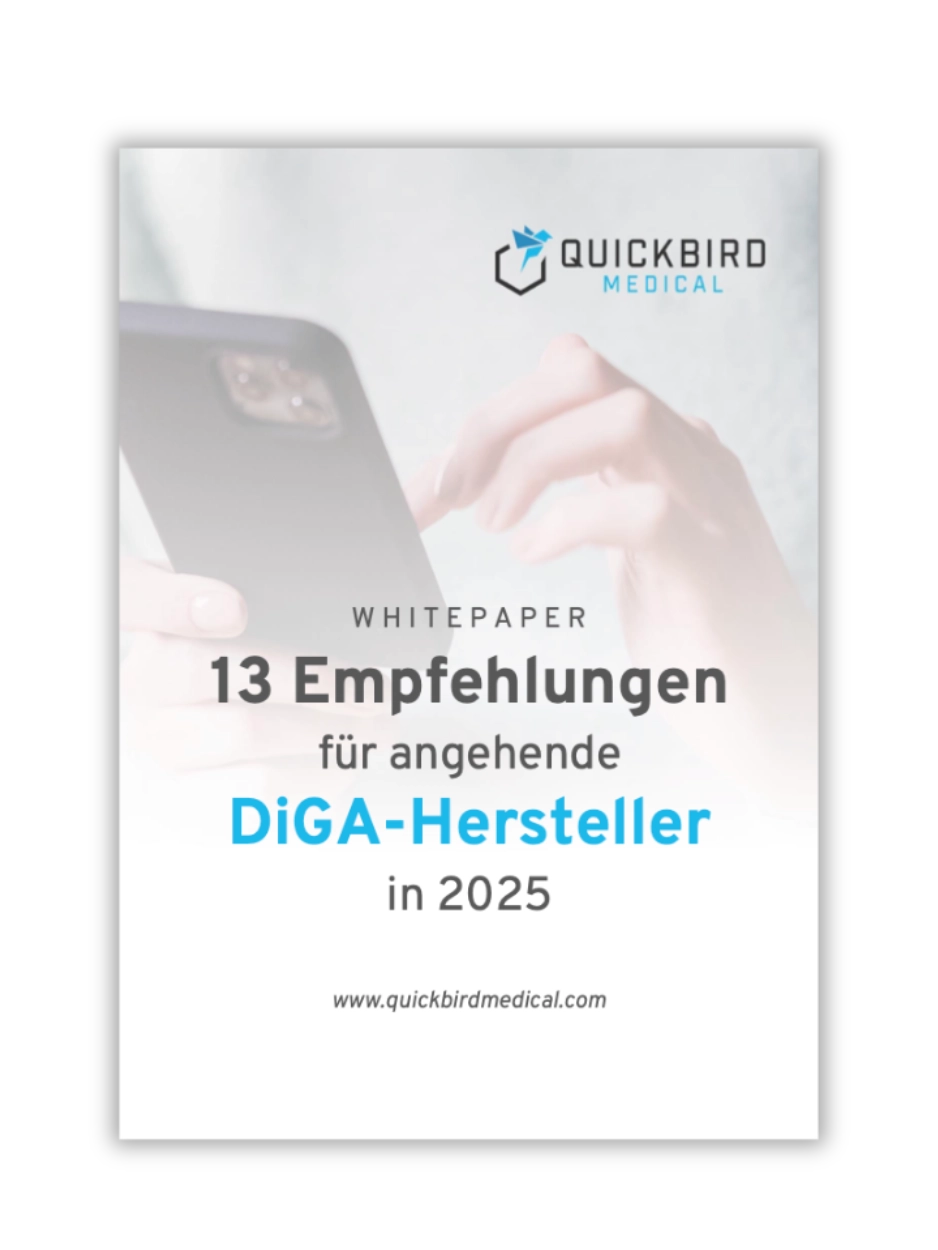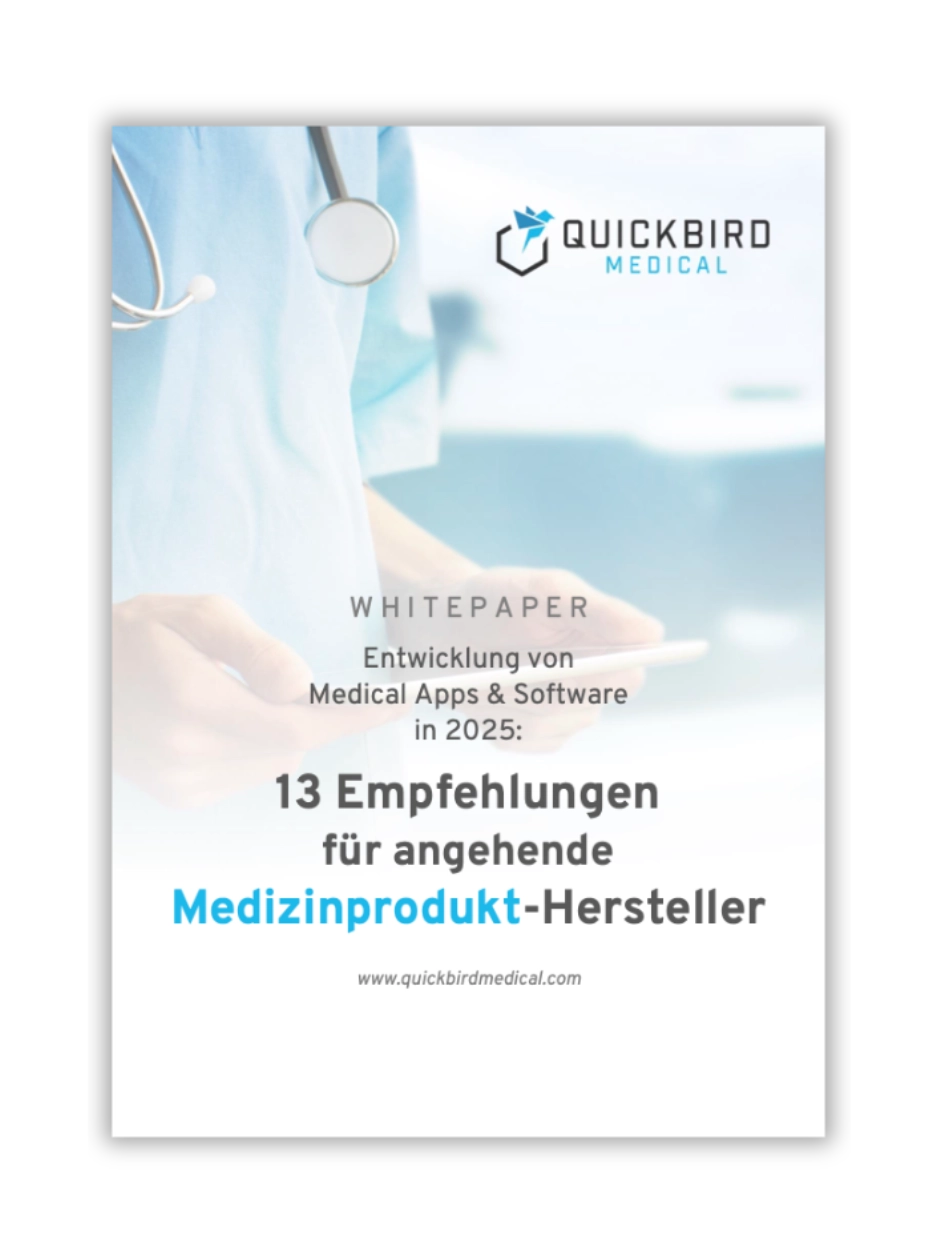The implementation of a digital health application (DiGA) involves effort and costs that should ultimately be worthwhile for your company. And indeed – many certified DiGAs that make it onto the market show extremely positive prescription and sales figures. Others, on the other hand, do not receive approval or fail even before submitting an application. But why is this the case? What factors influence the failure or success of your DiGA? In this article, we summarize the most important factors and recommendations that you should consider in 2023 when planning and implementing your DiGA through to approval.
1. Plan your clinical trial sufficiently
There are many influential paradigms in the start-up sector that allow entrepreneurs to increase the probability of success of their own company:
- “Move fast and break things” (Facebook)
- “Responding to change over following a plan” (Agile Software Development Manifesto)
- “Fail Faster”
These mantras and strategies are enormously helpful and important in certain contexts. When it comes to planning a medical device or a DiGA, however, advance planning is much more important than in the classic software start-up sector. Your DiGA must demonstrate a positive effect on care in a clinical study in order to receive certification and thus be permanently listed in the directory. These studies are very time-consuming and cost-intensive, which is why the budget is often only sufficient for one or two studies. As a result, you can only test or evaluate a limited number of product approaches. The pressure increases that the first approach must be the right one. You must therefore plan sufficiently to increase the probability of success of this approach. The planning of the DiGA should of course also take into account the results of any qualitative and quantitative user research. You can consider different approaches at the beginning. However, once you have decided on one, it is much more difficult to change direction. Apart from the product concept, it is also important to pay attention to the quality of the study. As you probably know, you need to carry out a comparative study. This involves answering the following questions, among others:
- How large should the sample be?
- For which patient group (ICD code) do you specifically want to obtain evidence?
- How do you gain access to this patient group?
- What is the current reality of their care?
- What are the ethical concerns about the study?
- How many comparison groups do you need?
- What is the procedure for assigning test subjects to groups?
- Which specific endpoints should be measured – and how do you want to collect them?
- How long must the DiGA be used to demonstrate a positive supply effect?
- What supply effect should your DiGA actually achieve?
It is best to look for a reliable partner for the clinical study who already has experience with DiGA and software studies in particular. In this article, you can find out how a clinical evaluation is carried out within the framework of the MDR. In addition, price negotiations with the GKV-Spitzenverband are due after the end of the trial period. This will determine how lucrative your application will be in the long term. The quality of your study and the strength of the positive effect on care are extremely important negotiating arguments that will enable you to achieve a permanently higher DiGA price. According to the draft Digital Act, which is expected to be passed in February 2024, 20% of the price will also depend on the success measurement accompanying the application: Only DiGAs that can demonstrate high usage duration or adherence, for example, will achieve the full negotiated price. You can read about all the important changes brought about by the Digital Act in our blog article Draft Digital Act: Impact of the DigiG for DiGA manufacturers.
Our recommendation: Check whether there is existing scientific evidence suggesting that your DiGA can demonstrate a positive care effect – and if so, what this looks like. Conduct initial qualitative and quantitative studies to generate additional data for the product concept. Also plan the study design really well (with a CRO if necessary) so that you don’t have any surprises during or at the end of the study. The cleaner your methodological approach is, the greater the chance of obtaining permanent approval and negotiating a higher price for your DiGA.
No certification as a DiGA without an indication and clinical study – but what about services that serve prevention? By creating the framework for digital prevention and health promotion services, the legislator has closed an important gap that was left open by the concept of the DiGA as a purely curative application.
2. Work with the right consultants
Especially in the medical device sector, you should look for partners who can provide you with targeted advice. Bad consultants cost you an enormous amount of time and money. Good consultants help you to enter the market quickly and cost-effectively. Unsuitable consultants are characterized by the following qualities, for example. They …
- … have little prior knowledge of standalone software. The consultants come from the hardware sector, for example, and have difficulties understanding the complexity and mindset of standalone software development.
- … have no experience with agile development, especially not in relation to medical products.
- … explain things in an unnecessarily complicated way and do not show a clear path to implementation.
- … artificially drive up consulting costs by making themselves irreplaceable. They block the transfer of knowledge to your company either knowingly or unknowingly.
Good consultants, on the other hand …
- … find pragmatic solutions that can be implemented creatively and concretely.
- … know the rules and how to follow them without burning resources unnecessarily.
- … develop solutions that fit into your company instead of imposing their standard procedures on you.
- … explain things in simple language and thus enable knowledge transfer to your team.
- … make themselves redundant bit by bit, so that your team will eventually stand on its own two feet.
- … do not organize a workshop lasting several days for every little problem, but help efficiently to find a solution.
Don’t forget that every month you are not listed as a DiGA, you are not making any money, but you still have costs. Therefore, good advice is absolutely integral to the success of your product.
Our recommendation: Ask your network for recommendations or contact us. We can help you with all DiGA and medical device issues or, if necessary, put you in touch with trustworthy consultants for your problem.
3. Target risk class I
For a while, there was a rumor that there would hardly be any software medical devices in risk class I under MDR. Fortunately, this turned out to be false. So far, almost all applications approved under MDR are assigned to risk class I in the DiGA directory. You can get a specific overview of this in our DiGA directory for manufacturers and on our DiGA dashboard. Whether your DiGA also falls into risk class I depends on various factors. Please read our guide to the classification of software medical devices according to MDR. In general, software in risk classes IIa or IIb involve significant additional work and costs for certification with a notified body. It is worthwhile designing the application in such a way that approval is granted under risk class I. We would be happy to advise you on this and evaluate whether risk class I could work for your product.
Our recommendation: Define your application in such a way that classification according to risk class I is possible. From risk class IIa, you will be faced with considerably more effort.
4. Do not underestimate the challenges of selling your DiGA
If your DiGA has been successfully included in the BfArM directory, this does not automatically mean that it will also be prescribed by doctors. And if your DiGA is not prescribed by doctors and patients do not become aware of its use themselves, you have no users and therefore no sales. The marketing and distribution of DiGA is a challenge for many manufacturers. The entire DiGA concept is still very new and little known among doctors and patients. As a manufacturer, you must therefore actively help doctors and/or patients to understand your product and at the same time see the individual added value. There are many approaches to this: specialized medical congresses, cooperation with pharmaceutical companies, offering DiGA seminars for doctors and other, more traditional advertising measures.
Our recommendation: Certification and approval alone are not enough: plan the distribution of yourDiGA and consider how your company can gain access to doctors and patients. Also be aware of the interests of these target groups and the best arguments to convince them.
You can also read our blog article on DiGA marketing and sales, in which we go into detail about the specific requirements for successfully marketing DiGA.
5. Choose a server provider in the EU
The GDPR poses major challenges for all companies operating in the EU. And the protection of personal data is of course particularly important in the healthcare sector. That is why the BfArM is once again imposing additional data protection requirements in the DiGA area for approval. In particular, the choice of suitable server providers is significantly influenced by this. Many services used by numerous apps are hosted on servers in the USA, where the level of data protection is often considered inadequate from a European perspective. For this reason, many DiGA manufacturers also opt for European alternatives in order to avoid being attacked by inspection bodies. If a US provider nevertheless offers massive advantages in your case, it is best to clarify at an early stage whether you can also fall back on such a provider from the BfArM’s point of view. We will be happy to provide you with comprehensive advice on this.
Our recommendation: If possible, choose server providers who can guarantee and prove compliance with the GDPR and the DiGA Regulation (DiGAV) in any case.
6. Choose the right target group
Choose a target group that will enable you to reach as many patients as possible. Important criteria for this are:
- How many patients with the target indications of your DiGA are there each year? Find out the prevalence of your target indications.
- How digitally savvy is your target group? People with diabetes between 20 and 30 are potentially more digitally savvy than people between 70 and 90 with dementia. If your target group does not generally use apps, it will be difficult to convince them to use a DiGA.
- Do you have existing access to the selected patient and/or physician target group? Can you use this access to effectively increase awareness of your DiGA?
- What is the current care context of your target group? Is your target group already receiving good care or are there any gaps in care? These gaps in care could be caused by long waiting times for doctor/therapist appointments, for example. In this case, a DiGA is probably a welcome help for your target group.
You can also get a good overview of the DiGA market by looking at the DiGA reports of the GKV-Spitzenverband or the individual health insurance funds. These publish statistics such as the number of DiGA prescriptions to date.
Our recommendation: Estimate how many people you can reach with your DiGA per year. Multiply this by the planned price of your DiGA and check whether the investment is promising. Also consider whether there are other patient groups that could benefit from your DiGA.
7. Evaluate alternative reimbursement options additionally
The DiGA Fast Track is not the only way to earn money with medical device software in Germany. For example, you should also consider financing your product via a selective contract with one or more health insurance companies. Although there is no standardized testing process for this, the requirements and hurdles for financing may be lower. On the following page you will find a comparison with the DiGA fast-track procedure. Of course, there are also many other financing options, e.g. through the Central Prevention Testing Center, self-payers or B2B models with hospitals and other companies.
Our recommendation: Evaluate in advance whether the DiGA Fast Track really suits your product and your company best. There may be attractive alternatives or additions to your financing model.
Here you will find a comparison of relevant points:
| Financing via selective contracts with health insurance companies | Financing via the Digital Healthcare Act (DiGA Fast Track) |
| Each health insurance fund must be convinced separately | Immediate access to reimbursement by all statutory health insurance funds |
| No transparent, standardized test criteria | Standardized, transparent test process |
| Focus is usually on possible cost reductions for health insurance companies | Focus can be on improving human health and is initially independent of the potential cost savings for health insurance companies |
| Scientific evidence must usually be available before the reimbursement date | Potential scientific evidence must be initially tested by means of an evaluation concept (and pilot study), but no full-scale clinical study must be available in the first year |
| No clear time frame for funding | Clear time frame due to legally stipulated examination deadlines (feedback within 3 months etc.) |
| Requirements for studies may be lower | Very high requirements for study design |
| Requirements for your application may be lower | High requirements for data security, data protection, accessibility, interoperability, etc. |
| Conceivable applications that cannot be legally approved as DiGA (e.g. primary prevention) | DiGA are restricted to patient-centered applications that are mostly used for therapy (read more about this in our blog article) |
You can find five more DiGA tips in our white paper…
You can find all further tips on approval and certification in our DiGA white paper. Simply download it using the form.
Conclusion
Increase the probability of success of your DiGA
Due to the regulatory hurdles, the development of a DiGA is not an undertaking that should be underestimated. However, with good planning and the right advice, there is a good chance that you will achieve approval in the DiGA directory. We hope that the above recommendations for the approval of your DiGA will help you to avoid unnecessary effort and potential risks. You can also find more information on topics such as the DiGA approval process, proving the positive care effect and price negotiation in our DiGA and medical software blog.




